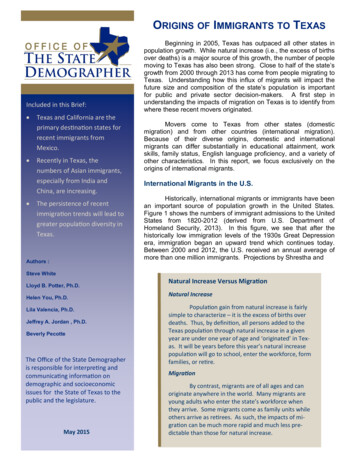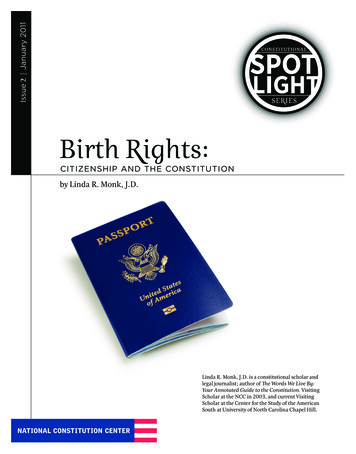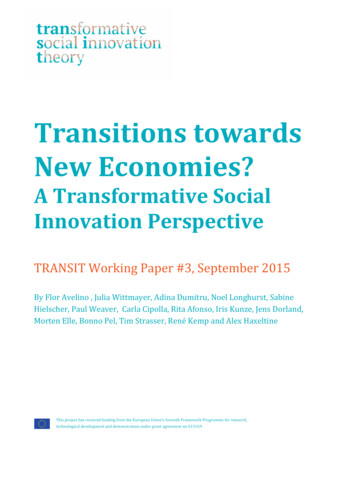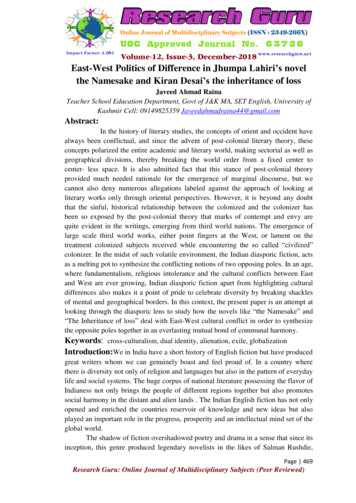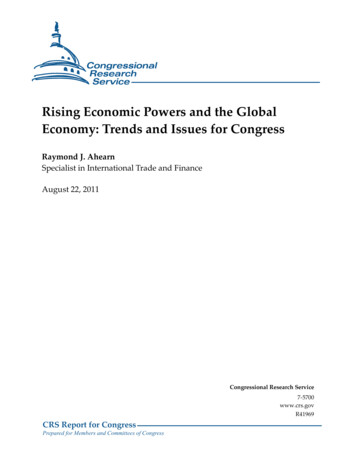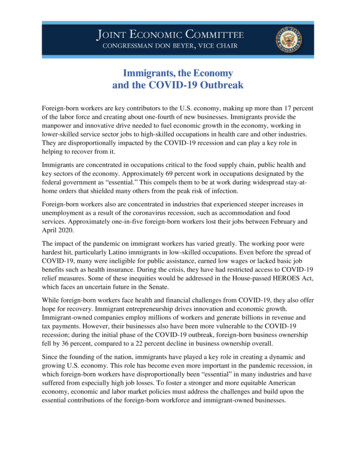
Transcription
Immigrants, the Economyand the COVID-19 OutbreakForeign-born workers are key contributors to the U.S. economy, making up more than 17 percentof the labor force and creating about one-fourth of new businesses. Immigrants provide themanpower and innovative drive needed to fuel economic growth in the economy, working inlower-skilled service sector jobs to high-skilled occupations in health care and other industries.They are disproportionally impacted by the COVID-19 recession and can play a key role inhelping to recover from it.Immigrants are concentrated in occupations critical to the food supply chain, public health andkey sectors of the economy. Approximately 69 percent work in occupations designated by thefederal government as “essential.” This compels them to be at work during widespread stay-athome orders that shielded many others from the peak risk of infection.Foreign-born workers also are concentrated in industries that experienced steeper increases inunemployment as a result of the coronavirus recession, such as accommodation and foodservices. Approximately one-in-five foreign-born workers lost their jobs between February andApril 2020.The impact of the pandemic on immigrant workers has varied greatly. The working poor werehardest hit, particularly Latino immigrants in low-skilled occupations. Even before the spread ofCOVID-19, many were ineligible for public assistance, earned low wages or lacked basic jobbenefits such as health insurance. During the crisis, they have had restricted access to COVID-19relief measures. Some of these inequities would be addressed in the House-passed HEROES Act,which faces an uncertain future in the Senate.While foreign-born workers face health and financial challenges from COVID-19, they also offerhope for recovery. Immigrant entrepreneurship drives innovation and economic growth.Immigrant-owned companies employ millions of workers and generate billions in revenue andtax payments. However, their businesses also have been more vulnerable to the COVID-19recession; during the initial phase of the COVID-19 outbreak, foreign-born business ownershipfell by 36 percent, compared to a 22 percent decline in business ownership overall.Since the founding of the nation, immigrants have played a key role in creating a dynamic andgrowing U.S. economy. This role has become even more important in the pandemic recession, inwhich foreign-born workers have disproportionally been “essential” in many industries and havesuffered from especially high job losses. To foster a stronger and more equitable Americaneconomy, economic and labor market policies must address the challenges and build upon theessential contributions of the foreign-born workforce and immigrant-owned businesses.
Immigrants, the Economy and the COVID-19 OutbreakKEY FACTS One-in-seven of the total U.S. population is foreign-born (46 million people). More than one-in-six workers in the United States are foreign-born (28 million workers). Almost half (48 percent) of the foreign-born labor force is Latino; about one-quarter (25percent) is Asian; 10 percent is Black and 16 percent is White. Foreign-born workers are overrepresented in key occupations in the field of health,accounting for 38 percent of home health aides, 29 percent of physicians and 23 percentof pharmacists. Immigrants make up 22 percent of all workers in the U.S. food supply chain, even thoughthey comprise only 17 percent of the labor force. Primarily as a result of the coronavirus recession, the number of employed foreign-bornworkers dropped from about 28 million in February to 22 million in April 2020. Foreign-born workers are more likely to be in the occupations that reached the highestunemployment rates during the onset of the COVID-19 outbreak:o service occupations (27 percent)o natural resources, construction and maintenance (16 percent) ando production, transportation and material moving (18 percent). About three-fourths of undocumented immigrants in the labor force are classified asessential. The health insurance coverage rate of all native-born residents is 93 percent, while thecoverage rate of foreign-born residents is 81 percent and the rate of noncitizens is 71percent. More than 15 million immigrants and persons living in households of mixed immigrationstatus were ineligible for direct payments under the 2020 CARES Act. More than one-in-four noncitizen children live in poverty. Immigrants start approximately 25 percent of new firms in the United States. The number of immigrant-owned businesses fell by 36 percent during the onset of theCOVID-19 outbreak, compared to an 18 percent decline in native-born businessownership.Page 2
Immigrants, the Economy and the COVID-19 OutbreakTABLE OF CONTENTSTHE IMMIGRANT LABOR FORCE5One-in-seven U.S. residents is foreign-bornImmigrants are more likely to be of prime working ageThe foreign-born are racially and ethnically diverseForeign-born workers who have completed only high school earn less than their nativeborn peers; those with college degrees earn slightly moreFRONT-LINE AND ESSENTIAL WORKERS7Immigrants are overrepresented in front-line health care occupationsThe COVID-19 response placed a higher burden on “essential” workersImmigrants are more likely to be “essential”Immigrant workers play a critical role in the food supply chainEXPOSURE TO THE CORONAVIRUS10High poverty levels make the foreign-born more vulnerable to COVID-19Immigrants live in places where COVID-19 deaths and infection rates are highestLatinos are far more likely than Whites to contract COVID-19THE ECONOMIC IMPACT OF COVID-1911Foreign-born workers have suffered higher job losses from the onset of the recessionEmployment of foreign-born males dropped precipitouslyEmployment of foreign-born women plummeted, widening the gender gapAN INADEQUATE SAFETY NET13Low-wage and undocumented immigrants often lack access to the federal safety netNoncitizens are least likely to have access to health insuranceImmigrants have restricted access to COVID-19 relief measuresENTREPRENEURSHIP AND OPPORTUNITY16Entrepreneurship provides a pathway for upward mobilityImmigrants rebounded more quickly from the Great RecessionThe spending power of immigrants can help drive aggregate demand and the recoveryCONCLUSION19TABLES AND MAPS20Page 3
Immigrants, the Economy and the COVID-19 OutbreakPage 4
Immigrants, the Economy and the COVID-19 OutbreakTHE IMMIGRANT LABOR FORCEOne-in-seven U.S. residents is foreign-bornThere are 46 million immigrants in the United States, making up approximately 14 percent of thepopulation.1 A little over half of all immigrants were born in Latin America. Approximately onethird were born in Asia, one-tenth in Europe and less than one-tenth in Africa or other regions.In this report, the terms “immigrant” and “foreign-born” are used interchangeably. Per the U.S.Census Bureau and Bureau of Labor Statistics (BLS), the foreign-born include all those bornoutside of the United States who were not U.S. citizens at the time of their birth, includingnaturalized citizens and noncitizens.2 Noncitizens include lawful permanent residents, asylees,temporary residents (including students and workers) and those who do not have legalimmigration status.According to the latest (2017) estimates available from the Pew Research Center, nearly half ofall immigrants are naturalized citizens (20.7 million), 27 percent are lawful permanent residents(12.3 million) and 5 percent are temporary residents with legal status (2.2 million).3 Overall,about three-fourths of the foreign-born population are authorized immigrants. Less than onefourth (10.5 million) are undocumented immigrants.Most undocumented immigrants entered the country with a temporary legal status that laterexpired. Others immigrated to the United States without authorization at the time of entry.4Immigrants are more likely to be of prime working ageEven before COVID-19, foreign-born workers were in high demand in the labor market.Immigrants help balance out the age composition of the nation’s population. The median age offoreign-born U.S. residents is 45 years old, which is nine years older than the median age of thenative-born population. The foreign-born are less likely to have children under age four or ofschool age. Only 6 percent are under 18 years old, compared to 26 percent of the native-born.About an equal percentage of foreign-born and native-born people are over the age of 65 (15.4percent and 16.4 percent, respectively). As many migrants come to the United States toparticipate in the labor market, immigrants are more likely to be in the prime working ages of 25to 54.5Immigrants contribute to the economy by supporting economic growth, technologicaladvancement and innovation. They increase the overall labor supply, filling in low- and high-endskill gaps.6 According to 2019 BLS estimates, there are 28.4 million foreign-born workers in theUnited States, accounting for 17.4 percent of the labor force.7Page 5
Immigrants, the Economy and the COVID-19 OutbreakThe foreign-born are racially and ethnically diverseLatinos comprised almost half (47.6 percent) of the foreign-born labor force in 2019, the lastyear for which data are available.8 Among non-Hispanic immigrants in the labor force, 25.3percent are Asian, 16.4 percent are White and 9.6 percent are Black.Immigrants are concentrated on the coasts and the Southwest, but increasingly live in theSouth and MidwestThe largest number of immigrants are concentrated in high-density coastal areas. However,counties with the highest immigrant populations are spread throughout the nation (see map). Theshare of foreign-born workers is higher in the West (23.5 percent) and the Northeast (20.2percent) than in the South (16.5 percent) and the Midwest (9.7 percent).9 Yet the South has thehighest number of foreign-born workers (9.8 million), compared to other regions (8.9 million,5.6 million and 3.3 million in the West, Northeast and Midwest, respectively).While large numbers of immigrants are still more common in coastal areas and the Southwest,the fastest-growing foreign-born populations are more dispersed across the country. Forexample, the five metropolitan areas with the largest populations each have over 1.5 millionimmigrant residents — New York, NY; Los Angeles, CA; Miami, FL; Chicago, IL; andHouston, TX. However, the immigrant populations of some smaller cities has grown rapidly;Charlotte, NC; Columbus, OH and Nashville, TN each grew by more than 30 percent between2010 and 2018.10Page 6
Immigrants, the Economy and the COVID-19 OutbreakForeign-born workers who have completed only high school earn less than their native-bornpeers; those with college degrees earn slightly moreAmong those aged 25 and over, immigrant workers are more likely not to have completed highschool (20.4 percent versus 3.9 percent, respectively). The share of the foreign-born labor forcewith a high school degree is about the same as their native-born peers (24.9 percent comparedwith 25.5 percent). Foreign-born workers are less likely to have some college or an associatedegree (16.2 percent compared with 28.6 percent). The foreign-born are also slightly less likelyto have a college degree or higher (38.6 percent compared with 42 percent).According to BLS, the median usual weekly earnings of foreign-born full-time wage and salaryworkers is 85 cents on the dollar compared to native-born workers. Foreign-born full-timeworkers who have completed high school earn 88 cents on the dollar compared to their nativeborn peers. Foreign-born workers with a higher level of education have a pay advantage. Nativeborn workers with a bachelor's degree or higher earn 96 cents on the dollar compared to theirforeign-born peers.Research shows that many international students stay to live in the United States aftergraduating, increasingly joining the U.S. labor force.11 Many work in high-skilled jobs. Inscience, technology, engineering and math (STEM fields), international students account formore than half of the master's degrees (54 percent) and slightly under half (44 percent) of thedoctorate degrees attained.12 Employers often recruit high-skilled foreign-born workers whenthere is a shortage of native-born workers. The unemployment rate in STEM fields for nativeborn and foreign-born adults tends to be lower than in non-STEM occupations. Research showsthat foreign-born workers can be complements to native-born workers, helping to create morejobs in the economy for native-born Americans.13FRONT-LINE AND ESSENTIAL WORKERSImmigrants are overrepresented in front-line health care occupationsForeign-Born Workers Provide Essential Health Care ServicesOccupationHome Health AidesPhysiciansPersonal Care AidesNursing AssistantsAll Health Care ServicesAll oreign-Born 1,00022%3,099,00017%Source: “Immigrant Workers: Vital to the U.S. COVID-19 Response, DisproportionatelyVulnerable” by Migration Policy Institute. Occupations that have a disproportionately higher shareof foreign-born workers compared to their overall share in the labor force ( 17.4%) shown.Page 7
Immigrants, the Economy and the COVID-19 OutbreakThe current pandemic accelerates the rising labor demand in sectors that face skill gaps at thelow-end and high-end of health care occupations, from home health aides to physicians. Publicfacing health care jobs — including nurses and medical assistants — often require non-Englishlanguage skills. Most medical interpreters are immigrant workers.14As Baby Boomers age and the health care system faces increasing demand due to COVID-19,immigrants will be even more critical to some of the fastest-growing health care occupations,such as licensed registered nurses and certified home health aides.15 Immigrants are overrepresented in the occupations of home health aides, physicians, personal care aides and nursingassistants — jobs that require they care for and keep in close contact with the sick and highestrisk during the pandemic. Millions of foreign-born workers have helped to continue criticaloperations on the front lines in health care and social services during the pandemic.The COVID-19 response placed a higher burden on “essential” workersOn March 19, 2020, the Cybersecurity and Infrastructure Security Agency (CISA) releasedguidance to help state and local jurisdictions and the private sector identify the “essential”workforce. Under the Department of Homeland Security (DHS), CISA states that essentialworkers are those employed in industries that are crucial to “ensuring continuity of functionscritical to public health and safety, as well as economic and national security.” Federal and stateguidelines directed others to stay home to slow the spread of the coronavirus.16The classification of being an essential worker involved a disproportionate burden on low-skilledworkers. Many already had greater occupational exposure and lower-paying jobs. A study by theCenter for Employment Equity found that 43 percent of essential workers are in low-wage jobs.17A study by Brookings estimates that there are 97.7 million essential workers that meet the federaldefinition, and most are in occupations where it is not typical to work from home.18According to the Brookings study, workers that are likely to be able to teleworkdisproportionately earn more and have higher educational attainment. They are also more likelyto be White. For this reason, during the stay-at-home or shelter-in-place phases of the initialoutbreak, lower-income, less-skilled and nonwhite workers were more likely to be exposed to thecoronavirus that causes COVID-19 (Sars-CoV-2).Immigrants are more likely to be “essential”Immigrants disproportionately work in essential jobs. The Center for Migration Studies foundthat there are 19.8 million foreign-born workers qualified as essential. Compared to 65 percent ofthe native-born labor force, a higher percentage (69 percent) of immigrants are in the essentialwork categories.19 About three-fourths of undocumented immigrants in the labor force are insectors classified as essential.According to 2019 BLS data, immigrants account for a disproportionate labor share of severalindustries that are primarily classified as essential, including agriculture, forestry, fishing andhunting (23 percent); construction (27.6 percent); manufacturing (18.6 percent); transportationand utilities (20.5 percent); professional and business services (20.7 percent); and leisure andPage 8
Immigrants, the Economy and the COVID-19 Outbreakhospitality (20.6 percent).20 Overall, immigrants account for just over 17 percent of the laborforce.The federal guidelines included many of the occupations in these sectors, with a large number offoreign-born workers being in accommodation and food services. More than 3-in-10 cooks, chefsand housekeepers are foreign-born. Immigrants account for about 1-in-5 food service managers,food preparation workers and cashiers.Immigrant workers play a critical role in the food supply chainThe nation's food sector relies on millions of foreign-born workers. These workers are spreadacross the supply chain — growing crops, harvesting fruits and vegetables, meat processing,transportation, wholesale trade and retail.21 According to the Migration Policy Institute,immigrants account for 22 percent of all workers in the U.S. food supply chain. In some areas,foreign-born workers are even more concentrated, comprising more than 3-in-10 workers inagriculture, crop production, meat processing and commercial bakeries. Among agriculturallaborers, graders and sorters, the share of foreign-born workers is over half.22 In some states, themajority of food workers are immigrants: 69 percent of the agricultural workers in California, 70percent of the seafood processing workers in Alaska and 66 percent of the meat processingworkers in Nebraska are foreign-born.23The global food supply chain depends on immigrant labor.24 As migrant workers help to ensurefood is on the table in households across the world, they face elevated occupational exposure tothe virus while lacking adequate protections or benefits, as demonstrated in the meatpackingindustry. Workers at one large meatpacking facility reported that the initial notice about thecoronavirus outbreak was only posted in English, putting the mostly non-English speakingworkforce at higher risk due to inadequate information about the COVID-19 outbreak.25In meat processing — where immigrants are 34.7 percent of the workers, the industry reached acrisis point soon after the outbreak. The chairman of a major food corporation warned on April26 2020, that the food supply chain is breaking. Soon after, President Trump signed an executiveorder to classify meat processing plants as essential infrastructure that must remain open,invoking the Defense Production Act. Yet the federal government failed to issue any mandatoryor enforceable worker protections. At the time, there was a 25 percent drop in the nation's meatsupply due to the closure of 17 plants.Amid fears of food shortages and rotting produce, few policies were enacted to improve theconditions for those contributing to the food supply chain. The availability of food in Americanhouseholds is primarily reliant on low-paid, immigrant workers — many undocumented.26Unsafe work and living conditions exacerbate other risk factors that migrant workers face.27Many who are undocumented lack access to health insurance, unemployment assistance andadequate housing or job benefits, such as paid sick leave.Migrant workers — even those with H-2A visas, which enable noncitizens to work in theagricultural sector — have little leverage to seek improved working or living conditions for fearPage 9
Immigrants, the Economy and the COVID-19 Outbreakof deportation or the risk of losing their visas if they leave their job.28 Others report going towork due to economic necessity despite the unsafe conditions.29EXPOSURE TO THE CORONAVIRUSHigh poverty levels make the foreign-born more vulnerable to COVID-19Noncitizen immigrants are twice as likely to be poor as the overall population.30 Compared toless than 1-in-10 families overall, a larger share of noncitizen family households is below thefederal poverty level (18.4 percent). The poverty rate among female-headed, noncitizenhouseholds is even higher, at 40.9 percent. More than 1-in-4 (26.6 percent) noncitizen childrenare poor, compared to 15.9 percent of native-born children and 16.3 percent of naturalizedforeign-born children.Research shows that those in poverty are more likely to have underlying health conditionsassociated with higher rates of hospitalization from COVID-19. For example, Americans livingbelow the poverty line and with lower household incomes are 50 percent more likely to see theirtreatment for asthma fail.31 Another study found that 16.5 percent of individuals living at orbelow the poverty level were at high risk of developing heart disease, compared to 9.5 percent ofhigh-income individuals.32 Low-income individuals are twice as likely to have diabetes and fourtimes more likely to smoke (36 percent compared to 8.8 percent).33Immigrants live in places where COVID-19 deaths and infection rates are highestWhile the Center for Disease Control and Prevention (CDC) does not provide data on COVID-19infection or mortality rates by nativity or citizenship status, places that have a larger immigrantpopulation — such as urban coastal areas — have higher COVID-19 mortality rates (see map).However, when the rates of COVID-19 cases or deaths are adjusted by population size, theconcentration becomes more spread out across the Midwest and South. The pattern for thepopulation-adjusted rates may reflect the higher infection and mortality rates among AfricanAmerican and Native American populations in these regions. However, available data areincomplete and often do not adjust for other demographic characteristics, such as age. Thepattern of infection and mortality is still unfolding.Latinos are far more likely than Whites to contract COVID-19Data recently released by the CDC by race and ethnicity show Latinos to be disproportionatelyaffected by a greater margin than the earlier data suggested. In some states and local areas,Latinos are much more likely than Whites to get infected. In Virginia, 49 percent of cases areLatino despite Latinos making up only 10 percent of the population of the state.34 In DurhamCounty, North Carolina, the Latino share of coronavirus cases increased dramatically, from 12percent to 67 percent from April to the end of May.35 Latinos comprise 13 percent of thepopulation in this county.Page 10
Immigrants, the Economy and the COVID-19 OutbreakThe jump in cases among Latinos may indicate a lag in seeking treatment or other underlyingindicators of vulnerability that might foretell increased risk among the immigrant population,especially given that just under half of immigrants are of Latino descent.THE ECONOMIC IMPACT OF COVID-19Foreign-born workers have suffered higher job losses from the onset of the recessionThe onset of COVID-19 contributed to the start of a recession in the United States in February2020.36 The dramatic labor market effects of the start of the outbreak can be captured bycomparing monthly data from the beginning of the downturn to two months outward — April2020. Much of the initial slowdown is not apparent in the data available for March 2020 becausehousehold and establishment surveys were conducted before the stay-at-home orders tookeffect. While preliminary data show an uptick in employment in May as businesses started to callback workers and reopening phases began in various states, the economic implications of thepandemic and progress toward recovery are still unfolding.Pre-pandemic, the preceding decade-long economic expansion had resulted in historically lowunemployment levels. The unemployment rate for foreign-born workers was 2.6 percent and 3.5percent for native-born workers in February 2020. That changed quickly when the coronavirushit the United States. From February to April 2020, the unemployment rate for native-bornworkers increased from 3.5 percent in February 2020 to 14 percent in April 2020. Foreign-bornworkers experienced an unprecedented increase, with the unemployment rate climbing from 2.6percent to 16.5 percent. In April, the foreign-born unemployment rate was higher by 2.5percentage points.The number of employed immigrants declined from 27.6 million to 21.9 million from February2020 to April 2020. One-in-five in the workforce lost their jobs. Employment reboundedsomewhat to 22.4 million in May.37 Foreign-born workers disproportionately work in thePage 11
Immigrants, the Economy and the COVID-19 Outbreakoccupations that reached the highest unemployment rates during the initial labor market collapsein April 2020: service occupations (27.1 percent, NSA), natural resources, construction andmaintenance (16.3 percent, NSA); and production, transportation and material moving (18.2percent, NSA).38 Both native-born and foreign-born workers in these industries facedunemployment spikes during the outbreak.Still, immigrants are more likely to work in these sectors and specific sub-sectors that were evenmore profoundly affected by the economic collapse. In just food services (and drinking places),there was a 5.2 million total loss in jobs in April 2020. Immigrants are also more likely to workin leisure and hospitality, personal and other services as well as in retail — which also suffereddeep job losses.39 Personal services saw an overall decline of 53 percent. Retail shed more than 2million total jobs, with losses in furniture and home furnishings and in clothing and clothingaccessories of 46 percent and 60 percent, respectively.Employment of foreign-born males dropped precipitouslyAnother way to measure job loss is to look at the rate of employment among the total population.This measure of the employment rate is called the “employment-population ratio.” Unlike thestandard unemployment rate, this indicator is not dependent on the size of the labor force orwhether persons entered or exited the labor market. It is a direct reflection of the share of thepopulation that is employed.Employment among foreign-born and native-born men never fully rebounded during the nearly10 years of economic expansion after the Great Recession. However, in April 2020, the historicalgap of foreign-born men having a higher employment rate than native-born men narrowed to 7percentage points from 10 percentage points a decade earlier. Employment among foreign-bornmen plummeted to 63 percent in April 2020, down almost 17 percentage points from its preGreat Recession high, while the employment-population ratio for native-born men fell to 56percent.Page 12
Immigrants, the Economy and the COVID-19 OutbreakEmployment of foreign-born women plummeted, widening the gender gapUnlike with men, foreign-born women historically have experienced lower rates of employmentthan native-born women. The pre-Great Recession peaks in the employment rate were 53.6percent and 57.7 percent for foreign-born women and native-born women, respectively — a gapof 4.1 percentage points.In April 2020, the decline in the employment rate was steep for foreign-born women — droppingto 41.1 percent. The employment gap experienced by foreign-born women widened to 5.7percentage points lower compared to native-born women and 21.9 percentage points lower thanthat of foreign-born men. Notably, the employment-population ratio for both foreign-born andnative-born women dropped below 50 percent. The drop is a marked change from the end of2019 when the percentage of women in the labor market had just surpassed the share of men.The steep declines and lower employment-population ratio among women highlight thesubstantial impact of the downturn by gender and the economic precarity of foreign-bornhouseholds, many of which rely on women's and men's income to escape poverty.AN INADEQUATE SAFETY NETLow-wage and undocumented immigrants often lack access to the federal safety netLow-wage migrant workers have minimal access to relief during the pandemic, even as thenation's economy and American households depend on them for essential services.Undocumented immigrants generally are ineligible for income support, health insurance or foodassistance programs. Immigrant residents with legal status can also face restricted access topublic benefits.Page 13
Immigrants, the Economy and the COVID-19 OutbreakThroughout the 1980s and 1990s, states passed laws limiting undocumented immigrants fromreceiving local public benefits, such as health care. For example, California promulgatedProposition 187 in 1994.40 In 1996, the Personal Responsibility and Work OpportunityReconciliation (PRWOA) Act restricted immigrant residents with legal status from receivingfederal means-tested programs for the first five years of U.S. residence.41 PRWOA also madeclear that undocumented immigrants are ineligible for federal public assistance. In the early2000s, measures expanded state's discretion in providing prenatal coverage to mother'sirrespective of their immigration status and in restoring access to Medicaid before the five-yearwaiting period (as established by the PWROA Act).42 However, undocumented immigrants stillare generally ineligible for federal programs such as Social Security, Medicare and SNAP.Despite their indicators of vulnerability, immigrants have limited to no access to governmentassistance programs available to nonimmigrants, making it more difficult to weather the personalimpacts and widespread disruptions of the pandemic.Noncitizens are least likely to have access to health insuranceThe COVID-19 pandemic has demonstrated the importance of access to health insurance andhealth care in protecting public health. To speed the public health and
Foreign-born workers are more likely to be in the occupations that reached the highest unemployment rates during the onset of the COVID-19 outbreak: o service occupations (27 percent) o natural resources, construction and maintenance (16 percent) and o pro

